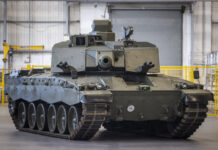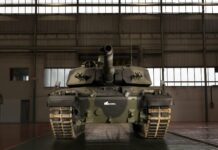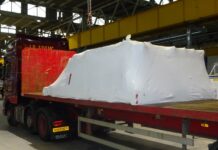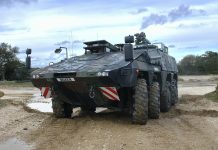Although the main battle tank has (arguably) not been entirely dislodged from its position as ‘Queen of the Battlefield’, the requirements of modern ground conflict have changed – immeasurably so – in the last two decades.
The exponential increase in the development of lighter, more specialised armoured platforms – manned, unmanned, tracked, wheeled, of all shapes, sizes and configurations – coupled with rapid advances in the capabilities brought by advancing technologies, have resulted in a new breed of armoured fighting vehicles. Something that remains common to all, unsurprisingly, is the imperative for excellent (and instant) situational awareness (SA), in a wide range of terrains and environments, including the increasingly significant electromagnetic spectrum.
Psychologists consider that situational awareness consists of three distinct elements: understanding; assessment; and decision-making. That is an entirely adequate definition from which to consider what is happening in enhancing, improving and facilitating efficient SA in today’s and tomorrow’s armoured vehicle fleets. These three elements reflect the logic of the Observe, Orient, Decide, Act (OODA) loop, which still lies at the heart of many of the techniques, tactics and procedures embraced by operational concepts across multiple nations. Fundamentally, the need to understand the environment in which the subject vehicle is operating is a fundamental precursor to the crew (or remote operator) being able to take effective action in time for it to be of use. Ukraine, Syria, Libya and the Sahel, for example, clearly show the synergies deriving from superior SA. This explains the huge increase in developments on the part of industry, constantly seeking solutions that better address the changing requirements of operators.

Credit: Rheinmetall
Those requirement changes are driven by many factors: discretion (the need for low-emission sensors); timely information (the imperative for real-time data and near real-time analysis); flexibility (an ability to discriminate difficult, often concealed targets at close and distant ranges); size, weight and power consumption optimisation; and intuitive, easily assimilated interfaces and data outputs. Users require SA assets that simultaneously provide accurate, reliable data, preferably with decision options, and are soldier-poof. In fact, the complex web of requirements and aspirations for SA on the battlefield, in the ‘urban canyon’ or in counter-insurgency operations can be broken down into three abilities: capability, affordability and interoperability.
Capability
Different approaches to providing SA capability can be seen in any cursory trawl through the relevant press or social media postings, whether emanating from observers of current operations, armchair generals or professionals. Some of the makeshift solutions seen in Ukraine recently verge on the bizarre – though many of them actually seem to work! Users contemplating upgrading legacy platforms or equipping future vehicles are often presented with a bewildering array of options, ranging from simple stand-alone sensors offering multiple options for range, spectrum and output, to fully-integrated systems that take every possible aspect of the vehicle’s sensor capability and make it a holistic, intrinsically easily absorbed construct that takes the operator directly into response mode.
The latter approach is the one taken by any number of current projects in the armoured vehicle sphere. Here we encounter the first inescapable truth – that talking about vehicular SA in isolation is possible only to a limited degree; the ubiquitous nature of sensors and their fundamental contribution to every aspect of a combat vehicle’s operations – survivability, firepower, mobility and combat effectiveness – coupled with the proliferation of other onboard systems demanding rapid data processing and analysis, means that an integrated system will, potentially, have greater utility than a host of disparate systems, no matter how great their utility.
That is the approach taken by, for example, the British Army’s Challenger 3 upgrade, which enhances and changes the vehicle’s SA capability radically. It is also reflected in the Israeli Carmel programme, which aims to provide a smaller than usual crew with swiftly gathered, processed and parsed data. It will be interesting to note, when the dust of current operations settles, what lessons the IDF will have learned from trialling early iterations of this technology in combat conditions. Larger-scale, integrated solutions have also been proposed by companies of the size and broad-spectrum capabilities of BAE Systems and Hensoldt, for example, with the latter’s Local Situational Awareness System (LSAS) offering a relatively painless entry to integrated SA.

Credit: RBSL
That approach, however, does not necessarily suit every existing or emerging requirement. Taking a dispassionate look at some of the vehicles now being fielded, developed and proposed, one cannot help but wonder whether the plethora of (mostly) roof-mounted sensors – visual, thermal, acoustic – necessarily contributes to an optimised capability. Low observability is still a critically important (and often underrated) component of survivability – hence the passion for sensors that exhibit the lowest possible emissions – and adding height and rectilinear profiles to a vehicle can somewhat thwart such an ambition.
Affordability
Practical considerations aside, there is another significant driver influencing the manner in which procurers and suppliers are approaching the issue of next-generation SA capabilities: the effect of increasingly stressed budgets. Both the so-called ‘Peace Dividend’ and the apparent commitment to significantly higher defence spending that started after Russia’s annexation of Crimea have more or less evaporated – despite a brief fillip caused by Putin’s 24 February 2022 invasion. The reality is that national governments – even in economies that are still more or less centrally controlled, such as China – are finding it increasingly difficult to come up with the sums required for development, manufacture and deployment of adequate solutions, in time and at scale. The pressures that treasury departments exert on those responsible for developing and acquiring capability mean that choices have to be made. Choices that, again inevitably, frequently favour the more obvious aspects of combat capability, such as more firepower or better armour, than what the bureaucracy might well see as the ‘intangible benefit’ of better SA. The inability of the uniformed services to convince the relevant organs of government of the real nature of those benefits means that the soldiers suffer.
The problem is that an integrated system – one that can almost instantaneously meld sensor-derived data into a simple decision matrix for the vehicle crew – is currently an expensive system. Many of the countries now pursuing upgrades and new equipment programmes, therefore, are seeking more affordable approaches to the conundrum. Which is where the age-old argument about sourcing once more rears its head: is it better to go with a solution from a tried and tested contractor, whose size and sometimes ponderous processes mean their systems frequently carry a higher-than-expected price tag? Or better to seek a more innovative and often more graceful solution from a smaller, less well-known vendor, while simultaneously doing everything possible to sensibly mitigate the risk?

Credit: Nir-Or
There is no easy answer. The comfort of a solution from ‘a usual suspect’ as opposed to a higher-risk one from a smaller, more agile alternative should not be too easily dismissed. Even when integration problems occur with adding an additional or replacement sensor to an existing vehicle backbone, finding workarounds can both resolve a utility issue and invigorate the industrial or military personnel developing the solution. Luckily, there is an alternative approach; one that has been around since the beginning of this century.
The Modular Open Systems Approach (MOSA), already mandated for a wide range of requirements by the US Department of Defense, and its corollary, the Sensor Open Systems Architecture (SOSA) aim to provide an environment in which proprietary interfaces and architectures become a thing of the past. In theory, this will enable smaller, agile concerns to develop and offer innovative solutions that will fit seamlessly into an existing architecture, thus avoiding expensive ‘tweaking’ to fit the application. The idea is simple, the implementation, sadly, not so much. Recently heard after a briefing was the question: “What is a MOSA, and where do I get one”? More education and a more constructive dialogue is required, but it seems likely that will only happen over a considerable period of time. Admittedly, initiatives such as the British-originated General Vehicle Architecture (GVA) concept, which subsequently became the NATO GVA, are starting to make a difference, but there is still a long way to go. Meanwhile, the third factor needs addressing.
Interoperability
A quick survey of the armed forces and security forces in Europe reveals over 120 different types of armoured vehicle – with more on the way as the unmanned ground vehicle community matures. Leaving aside the issue of different variants of a baseline platform and looking at the average number of sensors equipping a single platform, means there could be up to several hundred different sensors operating in a European joint force. As was the case with dismounted operations in Afghanistan, the inability of different units to communicate with each other because of national differences in equipment or software led to inefficiencies at best and actual casualties at worst.
There are multiple initiatives seeking to address this issue at different levels of the supply chain. At the component level, as just one example, several years have been spent in harmonising laser emissions and making laser devices common with respect to operations, interfaces, maintenance, etc. This is already the case in the training and simulation community and there are laudable efforts within the sensor community too. Currently, these are focused on avionics systems, but their applicability to the ground environment – where the scale of issue is normally far higher – is becoming more and more obvious to influential players. One cannot help but wonder, however, how we might best achieve the fundamental shift in thinking required in order to achieve something useful in time for it to be so.

Credit: Otokar
Challenges
That change in thinking applies to almost every aspect of modern combat. Increasingly, pundits are talking about another Revolution in Military Affairs, brought about by the technology-wrought changes in combat capability and the increasingly wide swathe of missions the armed and security services find themselves tasked with. Recent and current operations prove beyond a doubt that existing modi operandi will not suffice or, at least, will not provide the tactical or operational advantage sought. Therefore changes need to be made, which will require re-evaluating every aspect of the manoeuvre force, at the very least, with situational awareness being equally as important as firepower, mobility and survivability.
It is also worth reflecting that, as the complexity of data handling, processing and dissemination increases, so too does the cognitive load on the operator. Although there are huge strides being made in the direction of making that complexity transparent to the user, our training and support systems continue to lag behind. There is strong evidence that the mode of thinking in the personnel of today’s and tomorrow’s forces is subtly different from that exhibited by the previous generation, hence the extensive use of games technology in today’s training solutions. That recognition needs to be reinforced at every level of the military machine and kept in mind as new SA systems are defined, developed and deployed.
Perhaps the biggest issue, however – and the one that will cause the greatest debate, argument and controversy – centres on scale and speed. In every environment, from discussions of airborne sensors in Ukraine to the US’s ability to provide adequate counter-drone coverage for manoeuvre forces and critical infrastructure, a major challenge identified is being able to develop, test, procure, manufacture and issue equipment at scale and in a sensible timescale. For the vehicular SA community, failure to do so will result in rapidly degrading capability, huge wastage of resources and higher risk of damage, ineffectiveness and casualties. The moving finger has already written – we just need the wit do read it, understand it and do something about it. This need not be too difficult. After all, it’s really only a matter of perception.
Tim Mahon
An award-winning author, editor and consultant, Tim Mahon has a career in defence and aerospace spanning four decades. He is currently Publishing Director, Counter-UAS at Unmanned Publications












